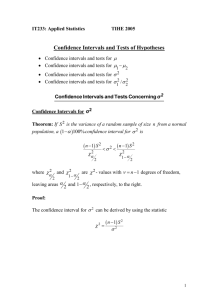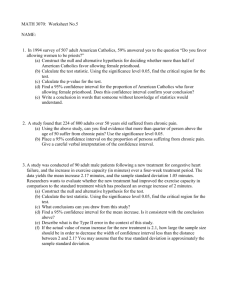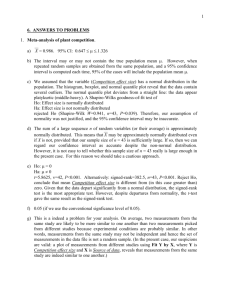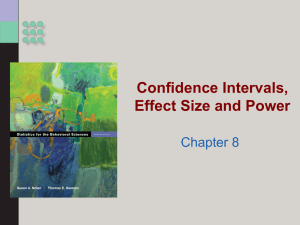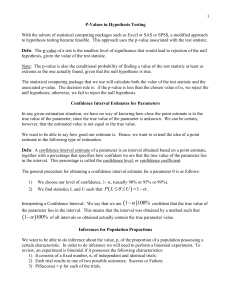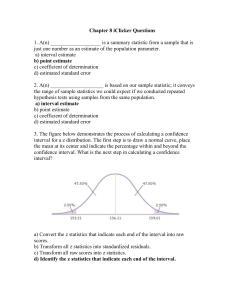Homework 4 Due Wednesday, July 27
advertisement
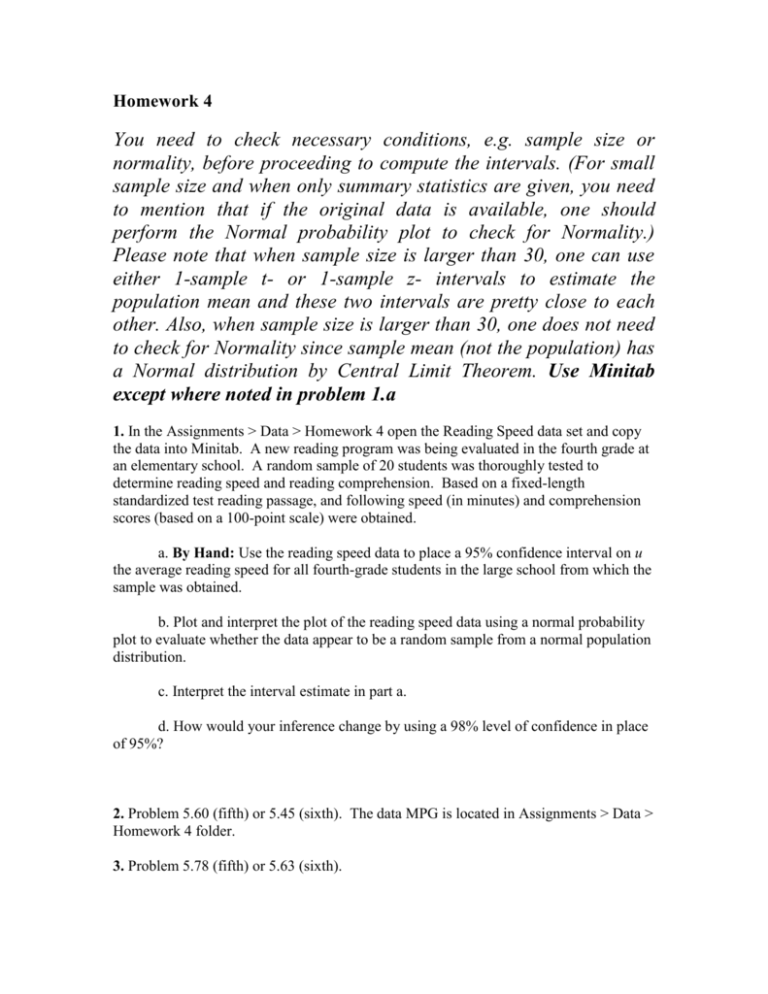
Homework 4 You need to check necessary conditions, e.g. sample size or normality, before proceeding to compute the intervals. (For small sample size and when only summary statistics are given, you need to mention that if the original data is available, one should perform the Normal probability plot to check for Normality.) Please note that when sample size is larger than 30, one can use either 1-sample t- or 1-sample z- intervals to estimate the population mean and these two intervals are pretty close to each other. Also, when sample size is larger than 30, one does not need to check for Normality since sample mean (not the population) has a Normal distribution by Central Limit Theorem. Use Minitab except where noted in problem 1.a 1. In the Assignments > Data > Homework 4 open the Reading Speed data set and copy the data into Minitab. A new reading program was being evaluated in the fourth grade at an elementary school. A random sample of 20 students was thoroughly tested to determine reading speed and reading comprehension. Based on a fixed-length standardized test reading passage, and following speed (in minutes) and comprehension scores (based on a 100-point scale) were obtained. a. By Hand: Use the reading speed data to place a 95% confidence interval on u the average reading speed for all fourth-grade students in the large school from which the sample was obtained. b. Plot and interpret the plot of the reading speed data using a normal probability plot to evaluate whether the data appear to be a random sample from a normal population distribution. c. Interpret the interval estimate in part a. d. How would your inference change by using a 98% level of confidence in place of 95%? 2. Problem 5.60 (fifth) or 5.45 (sixth). The data MPG is located in Assignments > Data > Homework 4 folder. 3. Problem 5.78 (fifth) or 5.63 (sixth). 4. Answer True or False to the following questions: a. Given any particular random sample, if we form the 95% confidence interval for the sample mean, there is a 95% chance that the population mean lies in this confidence interval. b. If a larger number of random samples are selected and we form the 95% confidence interval for each sample mean, the population mean will lie in about 95% of these confidence intervals. c. If a sample size is larger than 30, there is a 95% chance that the sample mean equals the population mean. d. If a very large number of random samples are selected, there is a 95% chance that one of the sample means is equal to the population mean. e. The 95% confidence interval around a given sample mean is wider that the 90% confidence interval around that same sample mean. 5. A test was conducted to determine the length of time required for a student to read a specified amount of material. The students were instructed to read at the maximum speed at which they could still comprehend the material because a comprehension test would be given on the material. Sixteen third-grade students were randomly selected from a large school district, and the results of their test are as follows (in minutes): 25, 18, 27, 29, 20, 19, 25, 24, 32, 21, 24, 19, 23, 28, 31, 22 a. Estimate the mean length of time required for all third-grade students to read the material, using a 95% level of confidence. b. What is the population for which the confidence interval in part a is applicable? c. Provide an interpretation of the confidence interval you computed in part a. 6. The city housing department wants to estimate the average rent for rent-controlled apartments. They need to determine the number of renters to include in the survey in order to estimate the average rent to within $80 using a 96% confidence interval. From past results, the rent for controlled apartments ranged from $300 to $1200 per month. How many renters are needed in the survey? 7. If the level of confidence in above question is increased to 99%, what sample size is needed? 8. Answer True or False to the following questions: a. To prove that u = uo with Type I error of 0.05, we must select a sample and fail to reject the null hypothesis Ho: u = uo using alpha of 0.05. b. If we reject the null hypothesis at the 5% alpha level, then we should also reject it the 1% alpha level. 9. In a statistical test about u, the null hypothesis was rejected. Based on this conclusion, which of the following statements are true? a. A Type I error was committed. b. A Type II error was committed. c. A Type I error could have been committed d. A Type II error could have been committed. e. It is impossible to have committed both Type I and Type II errors. 10. Complete the following statements (more than one word may be needed). a. If we take all possible samples (of a given sample size) from a population, then the distribution of sample means tends to be __________ and the mean of these sample means is equal to ___________ b. The larger the sample size, other things remaining equal, the _________ the confidence interval. c. The larger the confidence coefficient, other things remaining equal, the _______ the confidence interval. d. The statement “If random samples of a fixed size are drawn from any population (regardless of the form of the population distributions), as n becomes larger, the distribution of the sample means approaches normality,” is know as the ___________ 11. The FDA has to determine whether to let a drug go to the market. There are two possible hypotheses: 1. The drug has severe side effects. 2. The drug has no severe side effects. How will you set up the hypothesis? 12. A benign mucosal cyst is the most common lesion of a pair of sinuses in the upper jawbone. In a random sample of 800 males, 35 persons were observed to have a benign mucosal cyst. a. Would if be appropriate to used a normal approximation in conducting a statistical test of the null hypothesis Ho: π ≥ 0.096 (the highest incidence in previous studies among males)? Explain. b. Conduct a statistical test of the research hypothesis Ha: π < 0.096. Use pvalue and alpha of 0.05. 13. According to Fancorp (a consulting firm), “42% of franchises are purchased by husband-wife team.” A simple random sample of 32 franchise owners shows that 17 are owned by husband-wife team. Can you reject Fancorp’s claim at α = 0.034? Compute the p-value and draw a conclusion.

